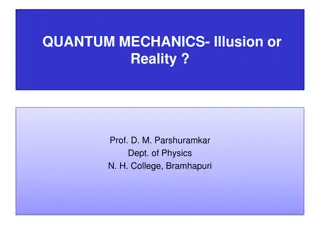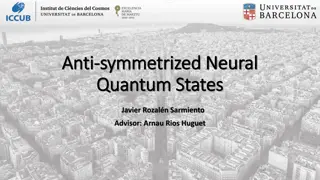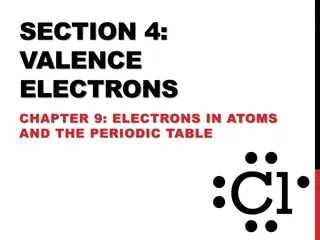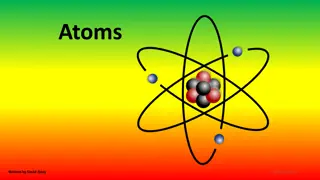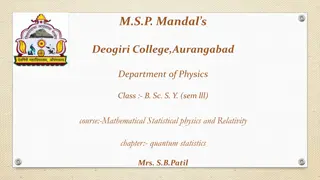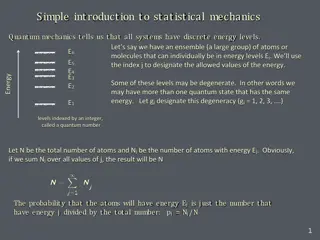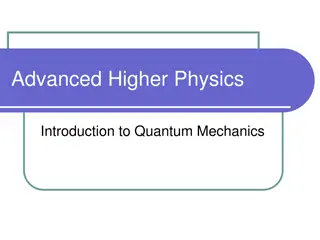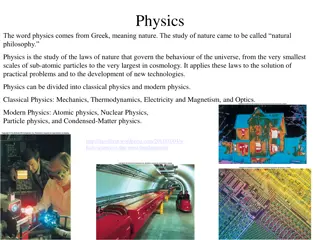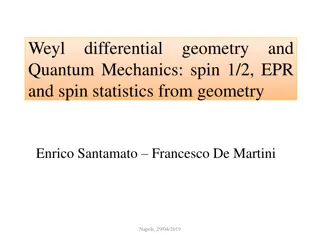Electrons in Atoms: Models and Quantum Mechanics
Explore the evolution of atom models from Rutherford to Bohr and the Quantum Mechanical Model. Learn about energy levels, electron movement, excitations, and orbital probabilities. Discover how electrons jump between energy levels and the limitations of Bohr's model in multi-electron atoms.
Download Presentation

Please find below an Image/Link to download the presentation.
The content on the website is provided AS IS for your information and personal use only. It may not be sold, licensed, or shared on other websites without obtaining consent from the author.If you encounter any issues during the download, it is possible that the publisher has removed the file from their server.
You are allowed to download the files provided on this website for personal or commercial use, subject to the condition that they are used lawfully. All files are the property of their respective owners.
The content on the website is provided AS IS for your information and personal use only. It may not be sold, licensed, or shared on other websites without obtaining consent from the author.
E N D
Presentation Transcript
Chapter 5 Electrons in Atoms Jennie L. Borders
Section 5.1 Models of the Atom The Rutherford s model of the atom did not explain how an atom can emit light or the chemical properties of an atom. Plum Pudding Model Rutherford s Model
The Bohr Model Niels Bohr studied the hydrogen atom because it was the most simplistic. Bohr proposed that an electron is found only in specific circular paths, or orbits, around the nucleus. Each possible electron orbit in Bohr s model has a fixed energy. The fixed energies an electron can have are called energy levels.
The Bohr Model The energy levels get closer together as you move farther from the nucleus. The energy levels also get higher in energy as you move farther from the nucleus.
Electrons Jump Electrons can jump from one energy level to another. A quantum of energy is the amount of energy required to move an electron from one energy level to another.
Electrons Jump An electron must gain energy to jump to a higher energy level. When an electron has jumped to a higher energy level, it is in an excited state. An electron must lose energy to fall to a lower energy level. When an electron is at the lowest energy level possible, it is at ground state.
Bohrs Model Restrictions Bohr s model accurately describes the movement of an electron in the hydrogen atom, but it cannot describe the movement of multi-electron atoms.
Quantum Mechanical Model The quantum mechanical model of the atom is based on the mathematical probability of the location of electrons using the Schrodinger equation. The quantum mechanical model stills has energy levels, but the exact path or orbit of the electron is unknown.
Quantum Mechanical Model Since the quantum mechanical model is based on the probability of finding an electron, then the orbitals are normally shaded with a fuzzy edge. An atomic orbital is a region of space in which there is a high probability of finding an electron.
Atomic Orbitals Within the border of an atomic orbital, there is a 90% chance of finding an electron. The darker the shading of the orbital, the higher the chance of finding an electron.
4 Atomic Models Plum Pudding Model Rutherford s Model Bohr s Model Quantum Mechanical Model + 90% chance of finding an electron
Energy Levels Each energy level can be composed of multiple sublevels. Energy levels are assigned a number from 1 to 7 based on the row on the periodic table. Each sublevel can be composed of multiple orbitals. The sublevels are assigned a letter: s, p, d, f, or g. Each orbital can hold a maximum of 2 electrons.
s Sublevel All s sublevels have 1 orbital and can hold a maximum of 2 electrons. The number in front of s represents the energy level. As the energy level increases, the size of the s sublevel increases, but it can still only hold 2 electrons. (Ex: 1s, 2s, 3s, etc.) The s sublevel has a spherical shape.
p Sublevel All p sublevels have 3 orbitals and can hold a maximum of 6 electrons. The p sublevel has a dumbbell or tear drop shape. Each tear drop is referred to as a lobe.
d sublevel All d sublevels have 5 orbitals and can hold a maximum of 10 electrons. The d sublevel has a four leaf clover shape (4 lobes) or 2 lobes and a donut.
f sublevel All f sublevels have 7 orbitals and can hold a maximum of 14 electrons.
g Sublevel All g sublevels have 9 orbitals and can hold a maximum of 18 electrons. There are not enough elements to fill in the g sublevels yet.
Electrons Sublevel # of Orbitals # of Electrons s 1 2 p 3 6 d 5 10 f 7 14 g 9 18
Section 5.1 Assessment 1. Why did Rutherford s atomic model need to be replaced? 2. What was the basic new proposal in the Bohr model of the atom? 3. What does the quantum mechanical model determine about electrons in atoms? 4. How do two sublevels of the same principle energy level differ from each other? 5. How can electrons in an atom move from one energy level to another?
Section 5.1 Assessment 6. How many orbitals are in the following sublevels? a. 3p b. 2s c. 4p d. 3d e. 4f
Section 5.2 Electron Arrangement in Atoms The electron configuration of an atom is the arrangement of the electrons. There are 3 rules that govern the electron configuration: Aufbau s principle, Pauli Exclusion principle, and Hund s rule.
Aufbaus Principle Aufbau s principle states that electrons occupy the lowest energy levels first. The following is a diagram of the order of the sublevels.
Electron Configuration Pauli Exclusion principle states that an orbital can hold at most 2 electrons. When 2 electrons occupy the same orbital, they have opposite spins. Hund s rule states that electrons would rather be separate than together in a sublevel with multiple orbitals.
Song to Remember the Rules To the tune of ABC s: Aufbau states that electrons like, to fill energy levels from low to high. Pauli exclusion states opposite spins, and that orbitals hold electrons like twins. Hunds rule states that electrons care, about being separate and not in pairs.
Arrow Electron Configuration When you write the arrow configuration for an element, the first step is to determine the number of electrons by using the atomic number. For negatively charged particles, add electrons. For positively charged particles, subtract electrons. The orbitals are represented as dashes above the sublevel. The electrons are represented by arrows. There can only be one up arrow and one down arrow in each orbital.
Sample Problem Write the arrow electron configuration for the following: B __ __ __ __ __ 1s 2s 2p __ __ __ __ __ 1s 2s 2p N V __ __ __ __ __ __ __ __ __ __ __ __ __ __ __ 1s 2s 2p 3s 3p 4s 3d Zn __ __ __ __ __ __ __ __ __ __ __ __ __ __ __ 1s 2s 2p 3s 3p 4s 3d
Practice Problems Write the arrow electron configuration for the following: Ti __ __ __ __ __ __ __ __ __ __ __ __ __ __ __ 1s 2s 2p 3s 3p 4s 3d S __ __ __ __ __ __ __ __ __ 1s 2s 2p 3s 3p Se __ __ __ __ __ __ __ __ __ __ __ __ __ __ __ __ __ __ 1s 2s 2p 3s 3p 4s 3d 4p
Standard Configuration When you write the electron configuration in standard form, the number of electrons in each sublevel is written as a power. You fill in the sublevels in the same order, but after you rearrange the sublevels in number order. Ex: 1s, 2s, 2p, 3s, 3p, 4s, 3d 1s, 2s, 2p, 3s, 3p ,3d, 4s
Sample Problem Write the standard electron configuration for the following: F 1s22s22p5 Ni 1s22s22p63s23p64s23d8 1s22s22p63s23p63d84s2 Ga 1s22s22p63s23p64s23d104p1 1s22s22p63s23p63d104s24p1
Practice Problems Write the standard electron configuration for the following: Ca 1s22s22p63s23p64s2 Ag 1s22s22p63s23p63d104s24p64d95s2 Al 1s22s22p63s23p1
Noble Gas Configuration (Honors) When writing electron configurations for large atoms, it is quicker to use the noble gas configuration. The noble gas configuration only includes the noble gas before the element and the last incomplete energy level.
Sample Problems (Honors) Write the noble gas configuration for the following: Te [Kr]4d105s25p4 Y [Kr]4d15s2 Ca [Ar]4s2
Practice Problems (Honors) Write the noble gas configuration for the following elements: Fe [Ar]3d64s2 Si [Ne]3s23p2 K [Ar]4s1
Exceptions to the Rules Sublevels are the most stable when they are full or exactly half-full. This causes electrons to jump to different sublevels to make the atom more stable. This jumping does not happen until the 3rd energy level. There are only 2 exceptions that you need to memorize.
Sample Problem Write the standard electron configuration for chromium. Since 3d is almost half- full, 1 electron from 4s moves to 3d. 1s22s22p63s23p63d44s2 1s22s22p63s23p63d54s1
Practice Problem Write the standard electron configuration for copper. 1s22s22p63s23p63d104s1 Do not use the exception for any element except Cr and Cu.
Section 5.2 Assessment 1. What are the three rules for writing the electron configuration of elements? 2. Explain why the actual electron configurations for some elements differ from those assigned using the Aufbau principle. 3. Arrange the following sublevels in order of increasing energy: 2p, 4s, 3s, 3d, and 3p. 4. Why does one electron in a potassium atom go into the fourth energy level instead of squeezing into the third energy level along with the eight already there?
Quantum Numbers (Honors) Quantum numbers are a set of 4 numbers that can describe any electron. The four numbers are represented by letters: n, l, m, and s. n is the principle energy level (1, 2, 3, 4, 5, 6, 7) l is the sublevel (s = 0, p = 1, d = 2, f = 3, g = 4) m is the orbital 0 -1 0 1 -2 -1 0 1 2 s p d -3 -2 -1 0 1 2 3 f s is the spin ( = 1/2, = -1/2)
Sample Problem (Honors) Write the quantum numbers for the following electrons: __ __ __ __ __ __ __ __ __ __ __ __ __ __ __ 1s 2s 2p 3s 3p 4s 3d 2, 1, -1, -1/2 0 3, 1, 0, 1/2 3, 2, -2, 1/2
Practice Problems (Honors) Write the quantum numbers for the following electrons: the last electron in Mn 3d5 = __ __ __ __ __ 3d 3, 2, 2, 1/2 The 6th electron 2, 1, 0, 1/2 __ __ __ __ __ 1s 2s 2p
Section 5.3 Physics and the Quantum Mechanical Model There are 4 properties of a wave that you need to be able to identify. The crest is the highest point of a wave. The trough is the lowest point of a wave. The amplitude the distance between the rest position and the crest. The wavelength (l) is the distance between two crests or two troughs.
Frequency The frequency is the number of waves that pass a given point in a certain amount of time. Frequency (n) is measured in Hertz (Hz). A hertz is s-1. c = ln c = speed of light (3.00 x 108 m/s) l = wavelength (m) n = frequency (Hz)
Sample Problem Calculate the wavelength of the yellow light emitted by a sodium lamp which has a frequency of 5.10 x 1014 Hz. 5.88 x 10-7 m
Practice Problem What is the frequency of radiation with a wavelength of 5.00 x 10-8 m? 6.00 x 1015 Hz
Electromagnetic Spectrum All electromagnetic waves travel at the same speed, so as wavelength increases, frequency decreases.
Atomic Emission Spectra The atomic emission spectrum is the set of specific wavelengths that are emitted when an element is electrified. The atomic emission spectrum is unique for each element just like fingerprints for humans.
Atoms Emit Light Atoms can emit light when you add heat, electricity, or reaction energy. The electrons start at ground state. When they absorb energy, they jump to a higher energy level (excited state). They have to lose the energy to fall back to ground state, and they lose some of that energy in the form of visible light. Atoms emit light when the electrons FALL to ground state.
Section 5.3 Assessment SKIP 1. How are wavelength and frequency of light related? 2. Describe the cause of atomic emission spectrum of an element.






